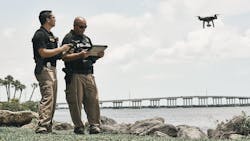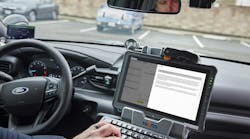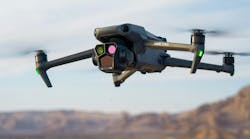By Alex Nollmann, Director of Government Sales, Panasonic Connect
Police departments confronted significant staffing shortages in 2022. Cities like Dallas, Texas, were down about 550 officers by mid-2022 and at the start of 2023, the Boston Police Department announced a "dire need" to fill positions, seeing 220 fewer sworn members year-over-year. It’s no surprise that Panasonic Connect’s survey of law enforcement professionals at IACP 2022 found that more than 80% of respondents were concerned with recruiting and employee retention. To address this concern, respondents called out their focus on ensuring technology helps with productivity and connectivity, streamlining data capture, and digitizing manual workflows.
As departments look to serve growing populations with minimal or no increase in headcount, technology will help. In fact, a 2020 study uncovered a correlation between increased use of information technology in police patrolling and a decreased crime rate. However, it will be critical for departments to prioritize the employee experience when developing a technology strategy. This includes the recruitment and retention of the “digital natives” of Generation Z who have grown up using technology in their daily lives. They have come to expect that same convenience in work environments.
Developing an effective technology strategy to promote positive worker experiences can be challenging. But, departments should feel encouraged knowing that — while there is an urgency to modernize — agencies can approach this goal in steps.
Equip Officers with the Right Mobility Solutions
With 240 million calls made to 9-1-1 each year, officers operate in fast-paced, mission critical environments where strategies can change at a moment’s notice. Whether on foot, in a vehicle, or in the office, they need to access critical information in real-time and maintain collaboration with their peers. If it isn’t already the top priority, equipping officers with the right mobile solutions should be at the forefront of an employee-centric technology strategy.
To boost the efficiency and effectiveness of each individual officer, agencies will often deploy mobile devices on a 1-to-1 basis. Officers’ demanding and unpredictable environments call for rugged devices designed to handle dust, rain, dirt, physical drops, sanitization, and more. Fully rugged devices and semi-rugged devices both offer significant durability in comparison to consumer grade devices, but agencies should choose an option that aligns with their department needs and includes the right features to best support their workforce. Picture an officer trying to conduct a covert operation at night, but the brightness of the laptop screen exposes his location. That’s where custom device features, such as concealed mode to dim or turn off the display, make a difference. Additionally, imagine an officer directing traffic during a storm so utility crews can repair a power line. The pouring rain threatens to interfere with the touchscreen on his tablet, while the weather and remote location pose challenges to his connectivity with central command. In these situations, features like rain mode, that ensure rain drops are not interpreted as entries, and strong antennas to provide reliable wireless connectivity help officers stay efficient and connected regardless of the environment.
Prioritize Solutions that Align with Your Workforce: Flexible, Connected, Current.
Mobile technology deployment is no small feat for agencies. When updating their solution stack, agencies need to know the fleet will last for a minimum of five years. Not only does this provide financial advantages, it eliminates unnecessary redeployment and retraining challenges. That said, officers and agencies are always looking for ways to take advantage of the latest technology solutions in their daily work. This is a fine balance to achieve: agencies cannot modernize at the expense of reliability.
In addition to carefully considering device features, police agencies need to explore solutions that offer flexibility for years to come. One way they can do this is through the deployment of modular devices. These solutions keep the same core device such as a laptop, 2-in-1, or tablet, but offer swappable components. Think barcode scanners, connectivity ports, hard drives, authentication readers, and more that allow agencies to switch out components to future-proof investments. For example, a few years after deploying mobile devices, an agency may decide to start scanning drivers licenses during traffic stops as opposed to manually typing the driver’s info into a computer. Instead of having to purchase all new mobile devices, they can add external barcode readers to their existing modular laptops and tablets without disruption.
The same rule applies to keeping officers connected. What makes mission-critical work like law enforcement unique is that the fastest, latest, and greatest technology isn’t always right for every situation. Here’s what I mean: 5G has its place in law enforcement. Being able to send large data packets such as video or high-resolution imagery changes the game situationally. 4G LTE can offer many of those same benefits. But, in remote locations or dense urban areas when connectivity can be compromised, how can officers plot an efficient, coordinated response? Connectivity to dedicated first responder networks is one option. Another is making use of Dual-SIM capabilities to allow officers to switch between networks in the event that one network goes offline. The moral being that law enforcement technology demands are broad.
Explore Solutions to Simplify Manual Tasks and Drive Efficiency
It becomes even more challenging to fill workforce gaps when you consider how much of an officer’s day is tied up in administrative and reporting tasks in addition to navigating disjointed workflows while moving from location to location to respond to calls. This not only hinders productivity and effectiveness, it also inhibits the employee experience. Take reporting, for instance. While tremendously important, it’s also a time-consuming task for officers. A 2021 study found that 38% of law enforcement professionals spend 2-4 hours per day on paperwork. Furthermore, 89% of respondents said creating incident reports limited the time they spend in their communities. This is time they could be using to build relationships with citizens and enhance their understanding of the area.
Agencies will see many benefits from streamlining this kind of process. A mobile device allows officers to complete reports from their vehicles, or from remote locations with secure access to central command. This way, they don’t have to wait until the end of their shifts to return to the police station and file all reports for the day. Instead, they can complete them from their vehicles while the incident is still fresh in their memory. Voice-to-text software takes this a step further. When officers sit in their vehicles, and are heads-down typing, they compromise their situational awareness. This software allows officers to recite reports aloud so they can keep track of what’s happening in the surrounding area. Not only does this application help officers file reports faster, it also promotes accuracy and efficiency by pre-populating certain information. Specific solutions that apply to unique law enforcement tasks should be the priority for agencies.
Consider IT as an Integral Part of Your Technology Strategy
When considering a technology strategy for law enforcement agencies, support and services offered by the technology provider should be a key factor. In the same ways agencies are struggling with officer recruiting and retention, IT departments are facing staff shortages amid an increased scope of work. Not only are they in charge of deploying technology across the organization, they are often the first call when a device malfunctions. This presents challenges when the device fleet is scattered across a large area.
In other industries, if a laptop won’t turn on or loses power, there might be delays in work. Maybe that person can go into an office and use a desktop or loaner. Maybe they can fire up an application on their phone to service a client. Yes, it’s a challenge, but it’s a manageable one. The same rules do not apply in law enforcement. When officers are responding to an emergency, a crisis, or a dangerous situation, there is no time for IT issues. A malfunctioning device means an officer could lose access to mission-critical information, compromising their situational awareness. Or, if there are issues throughout the day, the longer a law enforcement officer is on the sidelines, the less time they spend in the community.
Thus, agencies should look at the full lifecycle of technology deployments and seek out those with value-added services. IT teams should consider asset management needs, device health and monitoring, and even analytics dashboards that capture usage rates. These solutions bring a new level of visibility and predictability to an IT worker’s day, while also streamlining access to critical information on every asset out in the field. Why wait for a device’s battery to fail, when you can predict its degradation and schedule a replacement? Why survey workers on their device health and performance when you can automate device management dashboards? IT teams need a technology strategy that enables them to be more prepared to support officers in the field. This is non-negotiable.
Identify Ways to Enhance Collaboration and Informed Decision-making
More than 57% of respondents to Panasonic Connect’s IACP 2022 survey believe that informed decision-making and communication are the areas where technology will make the greatest impact on the public sector industry in the next five years. The move to connected, smarter, sensor-driven cities and workplaces is well underway. The public sector — specifically, law enforcement — needs to capitalize on this movement. Data points are being collected at all areas of officer workflows. It’s time to figure out how to share, analyze, and learn from data for more strategic and coordinated responses.
Imagine a police force collaborating with local firefighters, utility companies, and EMS professionals to respond to a severe storm. Officers on the ground call in for support. Instead of having to explain the situation in full over radio or phone, they can share real-time video and photos with their peers. They can also access floor or building plans, renderings, maps, and more. This capability gives these second-wave responders an added level of situational awareness so they can communicate and coordinate next steps with each other before they even arrive at the scene.
Looking Ahead
2023 will be an important year for police departments to revisit their technology strategies to support a positive worker experience and boost recruiting efforts. Mobile solutions will play a key role in these plans, as long as these solutions support flexibility, simplify manual workflows for greater efficiency, offer IT support services, and enable more informed decision-making. Above all, departments should ensure their technology strategy centers on supporting officers and IT teams.Author Bio
Since 2005, Alex Nollmann has been delivering Panasonic Connect mobility solutions to the public sector. He currently serves as Director for Government Sales at Panasonic Connect. Alex is responsible for establishing and managing an effective sales team that builds and maintains relationships with customers and channel partners as well as collaborating with a variety of business groups to create market-specific end-to-end solutions. With previous roles at Insight Public Sector and Havis, Alex has had the privilege of continually supporting the law enforcement community for 15 years, establishing himself as a subject matter expert in the design, procurement, and deployment of technology solutions that increase officer efficiency and community engagement.




